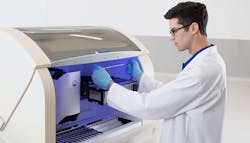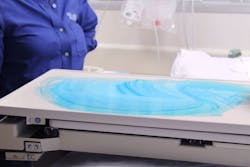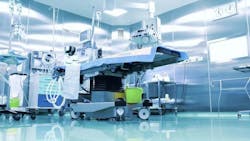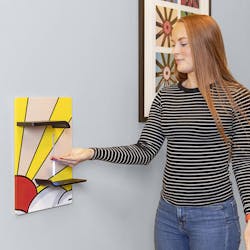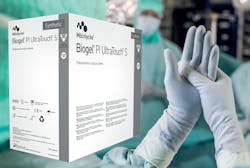Not many people like going to the hospital.
However, as we continue through our life’s journeys, we will often encounter illness or injury that either sends us or our loved ones to the hospital.
That being said, most of us all associate ‘going to the hospital’ with the process of receiving the treatment we need to get better.
We certainly don’t equate it with getting worse.
However, in the U.S., 1 out of 31 hospitalized patients are affected by a Healthcare-Associated Infection (HAI). Every year, that equates to 1.7 million infections and 99,000 associated deaths.1
MAX impact
Surgical site infections (SSI) account for up to 20% of HAIs, and surgical patients who develop SSIs have a 2 to 11-fold increase in mortality risk.2,3
There are countless means and methods, products and technologies involved in infection prevention today, and companies are continually developing strategies to combat infections spreading within healthcare facilities.
BD (Becton Dickinson) has been in the business of preventing HAIs for a long time, first with conventional, plated media and more recently, via molecular diagnostics. The company’s BD MAX system provides advanced testing to help clinicians make faster, more appropriate treatment decisions..
John Printen serves as Worldwide Business Line Leader, Acute Molecular Diagnostics, for BD Integrated Diagnostic Solutions (IDS).
“Since the launch of the BD MAX platform over 10 years ago, we have offered assays for Staphylococcus aureus (StaphSR) and Methicillin-resistant Staphylococcus aureus (MRSA), and that has long been our primary offering for surgical site infection (SSI), infection prevention and monitoring.
We do have a broader portfolio that fits into this HAI space, which includes Clostridium difficile (C. diff) and carbapenamase producing organism (CPO). With C. diff, many consider this an enteric or GI type of assay, however, at BD we include C. diff in the HAI space because it really is an HAI, as incidence of community-based transmission is relatively low.
All aboard the “stewardship”
According to Lauren Cooper, Senior Manager, Scientific Affairs for BD IDS, “driving diagnostic stewardship is an integral part of BD’s overall antimicrobial resistance (AMR) strategy and our extensive diagnostic capabilities—like the BD MAX—can help reduce the burden of drug-resistant infections through infection prevention and control, antimicrobial stewardship and surveillance.
Antimicrobial stewardship is a key factor in the battle against HAIs. Bacteria and viruses are often able to develop antimicrobial resistance to standard treatments.
To keep our assays current, we monitor different strains of MRSA that are becoming more prevalent, and we are always focused on keeping our assays up to date with emerging strains and emerging mechanisms of resistance.
The data is pretty clear; molecular screening is, by far, superior in quickly identifying and, therefore, helping support faster clinical decisions to reduce surgical site infections.”
A glove above the rest
The proper use of sterile gloves during surgery is one of the vital components of preventing SSIs.
Headquartered in Katy, Texas, Isikel specializes in the production of nitrile gloves.
Bill Williams, Isikel’s VP of Operations for glove manufacturing, is well established as the company’s ‘glove expert.’ He is firm in his statements that Isikel’s commitment to ‘gold gloves’ (they are actually blue) is second to none.
We have helped Houston hospitals and others maintain their supply levels. When other suppliers just were not getting them what they needed, we did. And, we have reinvested that philosophy into making sure that we are helping our customers maintain supply chain resiliency. We take pride in our American production and our glove design. We use a very lengthy leaching process to make sure that our glove is as non-allergenic as possible. Meaning that we go to great strides to make sure that we have the minimum number of accelerators and other chemicals that might have sensitivity issues.”
In addition, Isikel is one of the few companies that are manufacturing normal saline in the continental US; saline flushes play a key role in infection prevention by keeping tubes clean and sterile.
Williams added, “we are also doing saline flushes. It is just saline in the syringe form. As far as preventing infection, saline flush goes a terrific way toward that.”
Disinfection on a ‘cellular’ level
The hygiene of our hospitals is, quite literally, in our hands. And, it’s not just our hands, but what’s in our hands.
Claire Dobbin is the Sr. Product Manager at CleanSlate.
“It is known that 1 in 4 cell phones are contaminated with pathogenic bacteria in hospitals. It is an unfortunate fact that mobile devices are often forgotten and neglected to be properly sanitized; we even refer to them as the ‘third’ hand we never wash! This can pose a risk for cross-contamination between staff and patients.”
CleanSlate is a company that has gone beyond wipes or solution, and into the world of UV to guarantee cleanliness. The company’s latest development, the CleanSlate UV Versa, is an advanced UV sanitizer that conveniently fits into the work environments of hospitals and healthcare facilities.
Dobbin continued, “the idea (for Versa) originated due to high demand for UV solutions in healthcare, but, there was an issue with limited floor space available. We were able to penetrate the market with our other products into entrances, nurse’s stations, waiting rooms, etc. However, due to their large size, we were not able to deploy in high enough density to sanitize devices between patient care, creating gaps in accessibility for sanitizing devices.
It is also developed to ensure the best efficacy and product safety. We’ve made significant changes in the engineering design to improve both UV performance and device intelligence in a compact form. Our goal here is to provide hospitals with a solution that not only sanitizes phones but ensures that they also get the data insight needed to help improve their infection prevention & control practices.”
At the APIC show in 2022, healthcare professionals reacted very positively to seeing the new product.
Dobbin continued, “many agreed that a wall-mounted option was great for their facility as it would now provide better access for staff to sanitize their phones. It was great to hear this from many of the attendees as it was exactly what we had designed the Versa for.”
A wipe of a different color
Kinnos is a company that is turning many heads in the disinfectant industry with their application of ‘color technology.’ Their technological innovations revolve around the development of a colorizing additive for disinfectants known as Highlight, which is now being used by first responders, transit agencies, and several healthcare systems.
Highlight colorizes the wipes hospitals already use so staff can confirm their surface coverage and learn that wiping technique matters. The bright blue gives users instant visual confirmation of surface coverage, and fades if the surface is clean. Where it doesn’t fade is indicative of dust, debris, or gross contamination bound to a surface that requires another pass of wiping.
Rachael Sparks is Kinnos’ VP Marketing.
COVID heightened our awareness of how germs spread, yet the CDC reports that HAIs are now trending back upward. Hospitals are looking for innovations that can fix the weaknesses in the cleaning process. Highlight is providing hospitals with a simple but effective tool to improve the cleaning process quickly; and, it’s useful in every patient care space.
Hospitals utilize Highlight wherever they use bleach, comparing their cleaning scores without Highlight to with Highlight, and the results are staggering — essentially they are going from random A,B,C,D to Fs on their cleaning scores to consistent, 100% A+ scores. Many are beginning to standardize Highlight facility-wide as we launch quats compatibility this month, including daily cleans where patients can see and learn about the patient safety effort and reflect it in HCAHPS cleanliness scores.”
Smooth operator
Ecolab is a company that specializes in the areas of water, hygiene, and infection prevention solutions. The Ecolab Operating Room Program ensures proper cleanliness within the operating room and transforms turnover rates, while at the same time eliminating the chances of infection.
According to Olivia Broaddus, the Senior Marketing Manager, Healthcare, Digital Strategy, “the Ecolab Operating Room Program is designed to help monitor and standardize processes, optimize infection control and decrease turnover time in the OR. Ecolab delivers customized digital tools that collect data on OR Turnover time and high-touch object cleaning, as well as measures compliance and pinpoints precisely where corrective action is needed. These actionable insights allow higher operating room utilization and process improvements where they are needed most – standardizing workflows and keeping patients safe.
Broaddus continued, “Ecolab offers both in-person and on-demand virtual training for OR staff to develop and refresh core competencies for environmental cleaning and disinfection in the OR, standardize the knowledge base across the team, and sustain program outcomes. Depending on facility size, we can spend up to 3 weeks initially implementing the OR Program at a facility. We then provide refresher training and quarterly status reviews to identify successes and opportunities for improvement. Our goal is to ensure that every member is confident in our OR Program.”
ASP for sterilization
Advanced Sterilization Products (ASP) is focused on the proper care of instruments used in healthcare facilities, in particular, the reprocessing of endoscopes.
Julie Gorog RN, BSN, is a CNOR Clinical Education Consultant for ASP.
“One of the most challenging factors with reprocessing of endoscopes is failure to adhere to standards, guidelines, and manufacturer’s instructions for use.
“With ASP’s AEROFLEX Automatic Endoscope Reprocessor and EVOTECH Endoscope Cleaner and Reprocessor, MRC/MEC monitoring is automated and accurate for every cycle, reducing the patient risk associated with test strip errors.”
ASP’s STERRAD sterilisation systems utilize a low-temperature, hydrogen peroxide gas plasma technology to sanitise instruments efficiently.
Gorog continued, “best practices in quality monitoring of sterilization include every load monitoring with a biological indicator to confirm adequate conditions were met for sterilization. Improperly sterilized instruments put patients at risk for surgical site infections. Both AAMI and AORN recommend the use of a process challenge device which provides a challenge greater than or equal to your most challenging instrument to sterilize.4,5 AAMI standards state ‘PCD with the appropriate BI should also be used at least daily, but preferably in every sterilization cycle.’4
STERRAD VELOCITY BI/PCD is an all-in-one Process Challenge Device for STERRAD Systems that meets AAMI recommended guidelines and AORN recommended guidelines for monitoring with PCDs every cycle.”
Give them a hand
Vaask CEO Jon Olsen focused on the unique challenges of healthcare settings when designing the company’s hand sanitizing fixture.
“Hospital personnel have told us they are particularly concerned about the slip risk caused when sanitizer spills on the floor,” Olsen said. “Vaask’s laser sensor and high-end motor and pump take this hazard away.”
Even if a hand is pulled away just before dispensing, the pump will immediately stop and retract. The PalmPilot sensor accurately detects hands of all sizes and colors.
Vaask also takes a more sustainable approach to hand sanitizing.
“Our fixture is built to last using aluminum and steel, uses AC power or PoE (power over ethernet), and features a large-capacity, refillable sanitizer cartridge,” Olsen said. “No need to dispose of batteries or single-use cartridges.”
With Vaask’s connected platform, units don’t have to be individually checked and instead can be monitored from an app on your iPhone or Android device or PC.
“Facilities managers can get real-time estimates of how soon each unit will need to be refilled, saving on time and labor costs,” Olsen said.
Facilities have three options for installing Vaask’s hand sanitizing fixture. It can be recessed into a wall, in a mount attached to the wall or on a tip-resistant freestanding mount.
Global impact
Molnlycke has continually advanced their powder-free, low protein, Biogel gloves over the past 3-plus decades, always focused on materials that are healthier and provide better protection.
This includes moving away from natural rubber latex - which can cause allergies and even anaphylaxis - to polyisprene, a synthetic material that mimics the fit, feel and comfort of natural rubber latex.
Corinne Schmid, Molnlycke’s Senior Director of Marketing, discussed the company’s newest facility in Malaysia, as well as it’s in-depth conversion process.
“This same stringent inspection process will be in place at the newest Biogel factory opening this fall in Malaysia. The facility will manufacture Biogel surgical gloves with an aim to increase capacity by 50% and produce millions of gloves every year in a less energy intensive way.
Molnlycke draws upon deep experience to help facilities achieve their goals around standardization and reduced utilization, and deploys a surgical support team to optimize use across clinicians.
The high-touch conversion process begins with glove sizing, style selection and in-servicing. During the actual conversion stage, Biogel glove experts provide on-site support, including coordinating stocking. Post-conversion includes follow-up visits, efficiency reviews and CE edication on topics such as infection prevention, sharps safety, and other practices that increase effiency and enhance safety.”
References:
1 Septimus EJ, Moody J. Prevention of Device-Related Healthcare-Associated Infections. F1000Res. 2016 Jan 14;5:F1000 Faculty Rev-65. doi: 10.12688/f1000research.7493.1. PMID: 26918162; PMCID: PMC4754053.
2 Ban, K.A., “American College of Surgeons and Surgical Infection Society: Surgical Site Infection Guidelines,2016 Update”. Journal of the American College of Surgeons, 224(1): (2017), 59-74.
3 Awad, S.S., “Adherence to surgical care improvement project measures and postoperative surgical site infections”. Surgical Infection (Larchmt), 13(4): (2012): 234-7
4 American National Standard/Association for the Advancement of Medical Instrumentation (ANSI/AAMI). 2013(R)2018. ST58: Chemical Sterilization and High-Level Disinfection in Health Care Facilities.
5 . Association of Perioperative Registered Nursing (AORN). 2020. Guidelines for perioperative Practice. Sterilization. CO. AORN. a 13-point quality review to ensure quality; this includes mechanical, chemical, and microbiological testing.
In addition, every Biogel glove undergoes a 13-point quality review to ensure quality; this includes mechanical, chemical, and microbiological testing.
About the Author
Scott Tomko
Managing Editor
Scott Tomko was previously Managing Editor for Healthcare Purchasing News.

